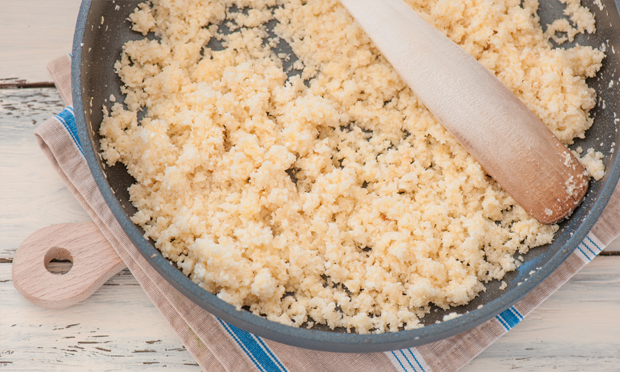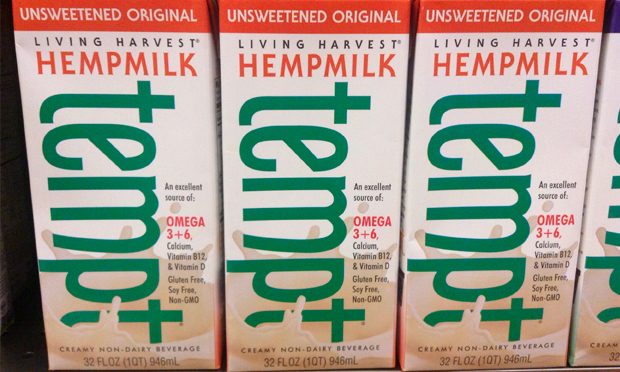Clean eating? Hackney? More like mucky eating

Some of the more outré ‘clean’ ingredients. Cauliflower ‘cous cous’. Photograph: stone-soup via Flickr.
If you are slim, fit, active, young, beautiful, radiant, rich and worried, get real, we Hackney citizens could tell you a thing or two. Clean/Mucky Eating is what we are good at.
We have markets, shops, food stores, cafés, restaurants, pop-ups and good home cooks (to list them all would fill this page) who care about what we eat, and how we come by it. Hackney has always been a place where clean eating can happen.
In the past it was a string of rural villages and farmland, near enough to London for merchants or lawyers to escape the unhealthy crowded city, with fresh air and fresh produce, mucky in a good way, from the rich soil and good pasture; the gentry built themselves spacious modern mansions, like Sutton House, or the later Paradise House, now Clissold.

‘A Young Daughter of the Picts’ by Jacques Le Moyne de al Morgue, c.1585
When centuries earlier our weary Roman legionary staggered home from the far North down Kingsland Road to the fleshpots of London for some R & R, he might have brought with him, as a GI Bride, the girlfriend of his dreams, a ‘Young Daughter of the Picts’, pictured here (right) in 1585 by Jacques le Moyne de la Morgue – not in stretch lycra as you might think, but tattooed in a way that would not have looked out of place in the tattoo parlours of Shoreditch today.
The Picts gave the occupying Romans a bad time, swooping down from Scotland to harass the outposts of the Empire. Archaeology reveals that the Picts made intricately patterned objects and enjoyed a healthy diet of meat, grains and greens, including kale, which might account for the glowing charms of this warrior maiden, so you could say clean eating came early to Hackney.
You have only to wander among Hackney’s markets and local shops today to see how many of us are thoughtfully buying stuff to take home and cook, not trendy foodies, but real people, holding down jobs, bringing up families, remembering family meals, past traditions of racial and religious diversity, keeping the kids healthy, unhampered by dogma or fads.
That’s the problem with the Clean Eating movement, its many good points are cancelled out by the cult status it has acquired. When one of our more distinguished food writers can be reduced to tears at, of all places, the Cheltenham Literature Festival, by a posse of Clean Eating zealots, it gets to look more murky than mucky.
Murky on several fronts; when young people with problems that involve food and eating are brainwashed into tormenting themselves over the things they must always or should never eat, the sin and wickedness is in those who have made themselves a pretty tidy fortune out of books and products, for the most part not based on scientific evidence, exploiting the worries of the vulnerable.
Details of these publications, programmes and products can be checked out on line: massive success, enormous sales figures, flaky content. By all means enjoy the colour photography and delicious recipes, but push the dogma and bad science to the side of your plate.
Giving up meat, dairy, carbohydrates, gluten, fat, sugar, salt, and going for expensive and weirdly named alternatives, is an option for individuals it might help, but not a recipe for healthy living for the rest of us. A lucid critical survey of the Clean Eating scene by Ruby Tandoh, in the Guardian, and online in Vice, puts things in perspective. Her wise advice is: ‘Eating well is eating intuitively, with pleasure and without shame. Whatever the wellness industry may tell you, you have the secret to wellness already. You’ve had it all along.’
The gruesome quest for ‘wellness’ and the pursuit of physical perfection can be depressing. Don’t go there. Get whatever exercise suits you, but keep off the competitive cults of fitness, and ignore the glowing bodies of the pampered rich.

Another clean eating oddity – hemp milk. Photograph: Mike Mozart via Flickr.
Me, I never saw my body as a temple, more of a World War II air-raid shelter, packed full of home comforts. Many of us in Hackney get our exercise when shopping for food, enjoying the wide range of ingredients in local shops, avoiding the supermarkets, with a shopping trolley as our fitness equipment.
Some messages for healthy food shoppers: remember that industrially produced ‘convenience’ meals are not designed for our health but for the health of the bank balances of shareholders and bosses, this is junk stuff made with the cheapest materials bolstered with additives and horrendous things that have nothing to do with well being, but all to do with profits; so never believe what it says on the tin or the promotional leaflet, be curious, cautious, sceptical, and bloody-minded about the small print in these post-truth days of alternative facts.
Read Joanna Blythman’s Swallow This, serving up the food industry’s darkest secrets, to find out about the horrors of processed food, and related activities like packaging and preservatives. Enjoy Bee Wilson’s First Bite, how we learn to eat for a balanced approach to learning good eating habits, ‘Clean eating is based on a flawed understanding of both health and food’, she says. Follow the moderate advice of Michael Pollan in his book In Defence of Food, an eater’s manifesto: ‘Eat food. Not too much. Mostly plants.’
